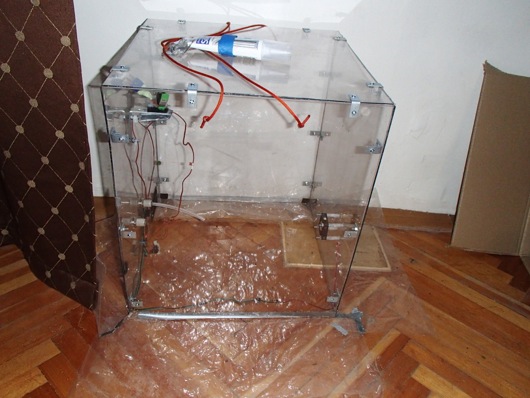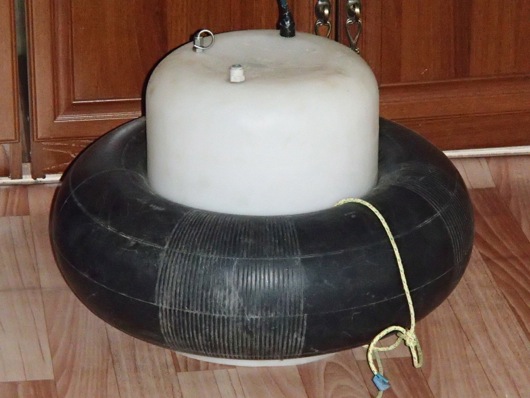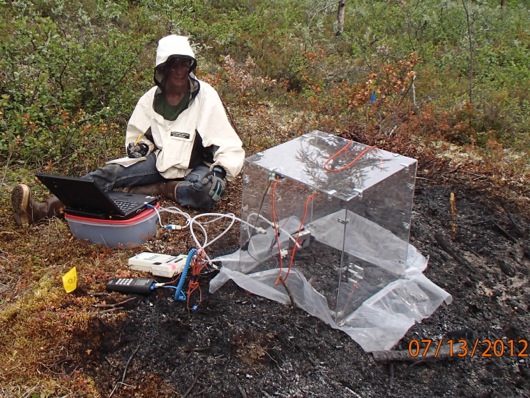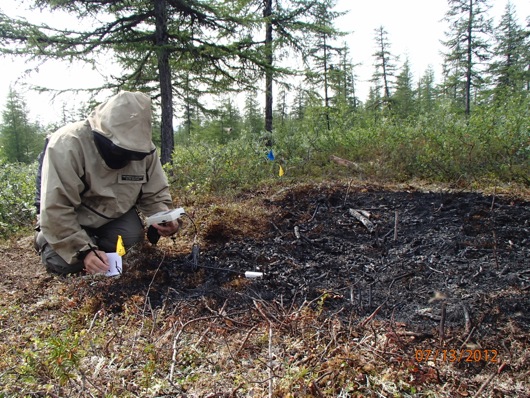(Mark Paricio is a PolarTREC Teacher accompanying the Polaris Project this summer. To read all of Mark’s journals, go to: http://www.polartrec.com/expeditions/siberian-arctic-systems-study )
Creative Contraptions
What are these two devices used for?

Device 1: The plexiglass cube above has five solid sides but no base.

Device 2: The plastic cylinder inside the tube is analogous to the cube.
Here’s a hint: They have essentially the same purpose but are used in different environments.
Creative Contraption 1
The top device is a flux chamber that measures the carbon dioxide gas released by the respiration of microbes and other organisms in the soil. Today, I accompanied Dr. Sue Natali of the University of Florida as we revisited the experimental burn plots from Dr. Heather Alexander’s experiment (for details on this experiment, please see my July 6 PolarTREC Journal). Here is a picture of Sue using the flux chamber on one of the plots that was burned.

Dr. Sue Natali (University of Florida) uses the flux chamber at a burn plot.
Basically, it is attached to a carbon dioxide sensor and measures the increase in carbon dioxide gas concentration over time due to the respiration of the organisms within the soil. When Sue is making these measurements, she is looking to see how the soil responds to the severity of the burn on that plot.
In general, Sue’s own work focuses on systemic flux of carbon dioxide from tundra to and from the atmosphere. An incredibly energetic and thoughtful scientist, Sue is a veteran of numerous Alaskan research projects (despite coming from the University of Florida!). Like myself, this is Sue’s first trip to Siberia.
Additionally, Sue and I spent the morning making photographic documentation of the plots as well as measuring soil moisture, conductivity, and the current thaw depth at five locations for each of the 16 experimental burn plots. After the fires and the last week of warm temperatures, she was a bit surprised by the depth to which the top active layer of soil had thawed from its frozen winter condition.
(NOTE: Remember that the active layer of soil is the part of the soil that thaws during the warmer summer months. Below the active layer is the permafrost layer that stays frozen throughout the entire year. Part of the research being done here is to determine the factors affecting this depth between the two layers. Other research tries to follow the pathways of the ancient carbon, that has been locked in the permafrost layer for thousands of years, as it becomes available to the environment again. Because this released permafrost carbon can be transformed into more greenhouse gases, warming the earth more, this warming cycle has the potential to spiral on itself – a positive feedback loop.)

Mark takes readings of soil moisture and conductivity on a burn plot. Photo by Sue Natali.
Creative Contraption 2
As you may have deduced by this point, Device 2 is an aquatic carbon dioxide gas flux chamber. This one can be used on water as the inner tube allows it to float on the surface, catching the carbon dioxide gas released by the lake or stream. Although the calculations are slightly different, it is one of the goals of the Polaris Project to determine the fate of both the organic carbon produced by modern organisms and the release of Pleistocene era carbon, currently stored in permafrost soils, that is released when these ancient soils thaw.
These tools help researchers get a handle on the carbon story.
Stay curious my friends! – Mark Paricio



